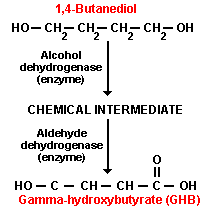 | 1,4-Butanediol (BD): Danger! |
 | 1,4-Butanediol (BD): Danger! |
1,4-Butanediol: An Overview Its chemical
formula is C4H10O2. You can purchase it
on the Internet. It is in industrial cleaners. It is used in polyurethane
to make car bumpers. It is used to make Spandex. It is also an abused
recreational drug that has been linked to two deaths and six severe
illnesses. "It" is 1,4-Butanediol (BD). Its chemical
formula is C4H10O2. You can purchase it
on the Internet. It is in industrial cleaners. It is used in polyurethane
to make car bumpers. It is used to make Spandex. It is also an abused
recreational drug that has been linked to two deaths and six severe
illnesses. "It" is 1,4-Butanediol (BD).
BD=GHBOnce ingested, BD (and a similar chemical, GBL) turns into gamma hydroxybutyrate, GHB. GHB, the so-called "date-rape" drug, received national attention when two teenage girls died after it was slipped into their sodas. As a result of this case, GHB was declared a restricted drug (classified Schedule I) in March 2000. There is now a 20-year maximum jail term for the illegal manufacture or trafficking of GHB.GHB is illegal, but BD is not. This is like banning peanut butter but leaving peanuts on the grocery store shelves. As a first step toward banning BD, the US Food and Drug Administration declared BD a Class 1 Health Hazard in 1999. Since then, manufacturers have been asked to recall products containing BD (or GBL). These include Blue Nitro, Borametz, Serenity, BioMetabolic P.M., and Zen. As evidence mounts that BD is as dangerous as GHB, Congress will consider making BD a Schedule I drug. In the meantime, the National Institute on Drug Abuse has teamed with several organizations to launch a $54 million-dollar campaign to educate the public about the dangers of GHB and other club drugs. BD is available legally in large quantities for industrial uses; one recommendation has been to color the clear liquid BLUE so that it cannot be slipped undetected into someone's drink.
How BD affects Your Body BD affects the
central nervous system in a way similar to alcohol. It relaxes people and
makes them sleepy. It also slows central nervous system functions, causing
a reduced breathing rate and slowed reflexes. As with alcohol, too much BD
can cause a person to lose consciousness, lose control of his bladder or
bowels, experience seizures or fall into a coma. Many car accidents have
been caused by people who have taken BD or GHB. BD is also addictive
and when it is discontinued after regular use, people may have withdrawal
symptoms such as feelings of anxiety, severe sweating,
tremors and muscle aches, and audio or visual hallucinations. BD affects the
central nervous system in a way similar to alcohol. It relaxes people and
makes them sleepy. It also slows central nervous system functions, causing
a reduced breathing rate and slowed reflexes. As with alcohol, too much BD
can cause a person to lose consciousness, lose control of his bladder or
bowels, experience seizures or fall into a coma. Many car accidents have
been caused by people who have taken BD or GHB. BD is also addictive
and when it is discontinued after regular use, people may have withdrawal
symptoms such as feelings of anxiety, severe sweating,
tremors and muscle aches, and audio or visual hallucinations.
ER Visits Illuminate BD ToxicityDeborah Zvosec, PhD, and a team of researchers examined emergency room patients who had ingested BD and cataloged the symptoms associated with BD toxicity. The study was published in the January 11, 2001 issue of the New England Journal of Medicine. This is the first study on the toxic effects of BD. The researchers verified that the patients had ingested BD by using a technique called gas chromatography-mass spectrometry, which measured the level of BD in various body fluids. This analysis provided the researchers with information about the dose of BD each patient had taken. The patients' vital statistics, such as heart rate, blood pressure, amount of oxygen in the blood, respiratory rate and rating on a coma scale were recorded. Based on this and other studies on GHB, the authors state that BD and GHB affect the neurotransmitters dopamine and GABA. GHB can affect brain blood flow and glucose metabolism, temperature regulation and sleep patterns.
First-Aid for BD or GHB Ingestion:
|
| Did you know? ? |
|
Further reading:
|
| GO TO: | Alcohol | Amphetamines | Caffeine | Cocaine |
| Heroin | Inhalants | LSD | Marijuana | |
| Nicotine | Ecstasy | Rohypnol | 1,4-Butanediol | |
| GHB | Barbiturates | PCP | Hallucinogenic Mushrooms | |
| BACK TO: | Table of Contents | Drugs Effects on the Nervous System |
![[email]](./gif/menue.gif) Send E-mail |
![[newsletter]](./gif/menunew.gif) Get Newsletter | ![[search]](./gif/menusea.gif) Search Pages |
 Donate to Neuroscience for Kids |
Page prepared by Ellen Kuwana, Neuroscience For Kids, Staff Writer - Last modified on May 16, 2005